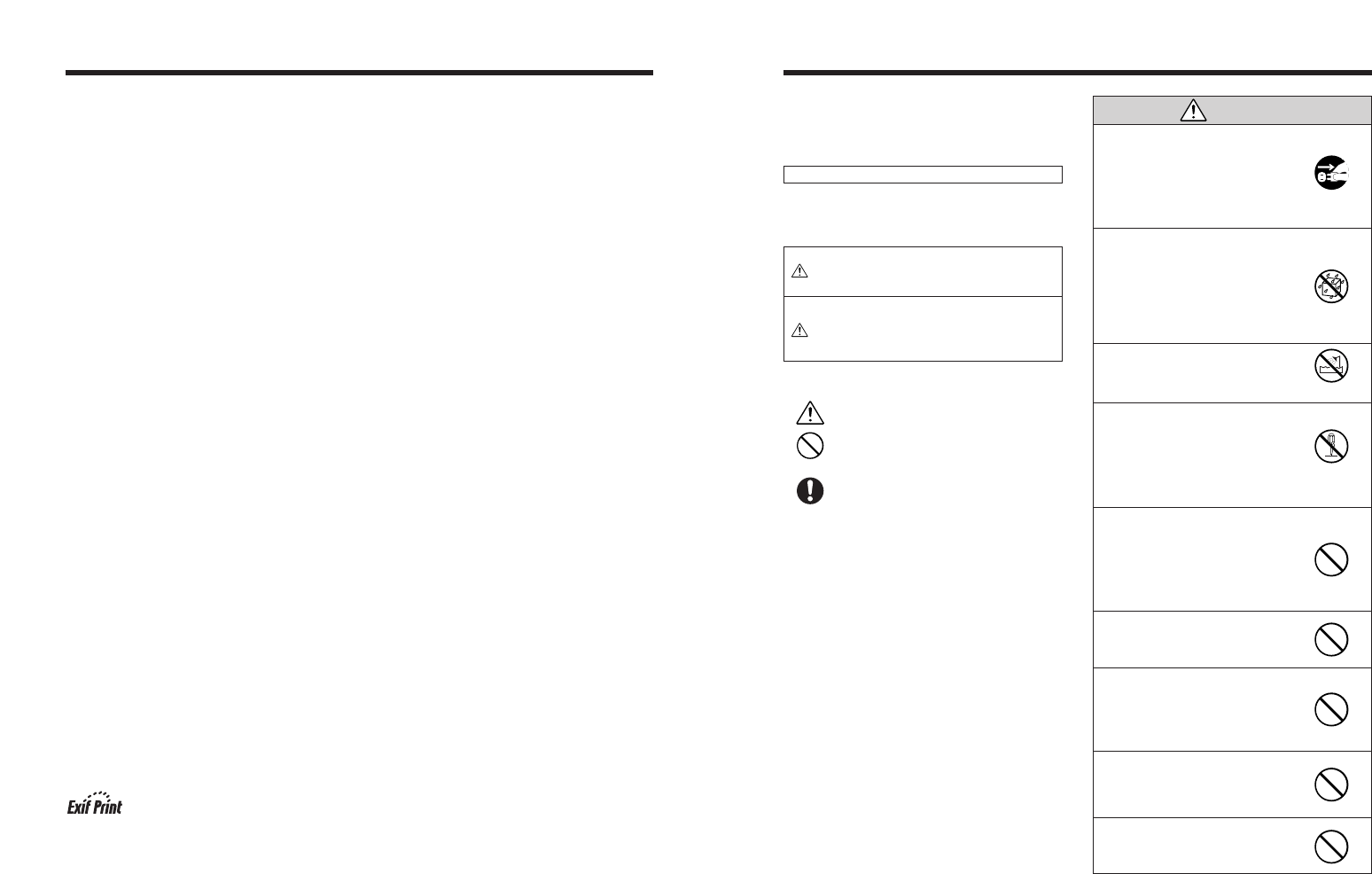
141
Safety Notes
h Make sure that you use your FinePix S3 Pro camera
correctly, read these Safety Notes and your Owner’s
Manual carefully beforehand.
h After reading these Safety Notes, store them in a
safe place.
About the Icons
The icons shown below are used in this document to
indicate the severity of the injury or damage that can
result if the information indicated by the icon is ignored
and the product is used incorrectly as a result.
WARNING
This icon indicates that death
or serious injury can result if
the information is ignored.
CAUTION
This icon indicates that
personal injury or material
damage can result if the
information is ignored.
The icons shown below are used to indicate the nature
of the information which is to be observed.
Triangular icons tell you that this
information requires attention (“important”).
Circular icons with a diagonal bar tell you
that the action indicated is prohibited
(“Prohibited”).
Filled circles with an exclamation mark tell
you an action that must be performed
(“Required”).
If a problem arises, turn the camera
off, remove the batteries, disconnect
and unplug the AC power adapter.
Continued use of the camera when it is
emitting smoke, is emitting any unusual
odor, or is in any other abnormal state
can cause a fire or electric shock.
h Contact your FUJIFILM dealer.
Do not allow water or foreign objects
to enter the camera.
If water or foreign objects get inside the
camera, turn the camera off, remove
the batteries and disconnect and
unplug the AC power adapter.
Continued use of the camera can cause
a fire or electric shock.
h Contact your FUJIFILM dealer.
Do not use the camera in the
bathroom or shower.
This can cause a fire or electric shock.
Never attempt to change or take
apart the camera. (Never open the
casing.)
Do not use the camera when it has
been dropped or the casing is
damaged.
This can cause a fire or electric shock.
h Contact your FUJIFILM dealer.
Do not change, heat or unduly twist
or pull the connection cord and do
not place heavy objects on the
connection cord.
These actions could damage the cord
and cause a fire or electric shock.
h If the cord is damaged, contact your
FUJIFILM dealer.
Do not place the camera on an
unstable surface.
This can cause the camera to fall or tip
over and cause injury.
Never attempt to take pictures while
in motion.
Do not use the camera while you are
walking or driving a vehicle.
This can result in you falling down or
being involved in a traffic accident.
Do not touch any metal parts of the
camera during a thunderstorm.
This can cause an electric shock due to
induced current from the lightning
discharge.
Do not use the batteries except as
specified.
Load the batteries with the ≠ and –
marks.
WARNING
Unplug from
power socket.
Do not use in the
bathroom or shower.
Do not
disassemble.
140
Explanation of Terms
Adobe RGB (1998)
A color space introduced as the working color space for Adobe Photoshop 5.0. AdobeRGB
encompasses almost all the colors reproduced by CMYK printers and is intended primarily for
printing applications. It was introduced as “SMPTE-240E” in the RGB settings in Adobe Photoshop
5.0 and as “Adobe RGB (1998)” in the profile settings from version 6.0 onwards.
CCD-RAW
This is the image data prior to signal processing (the reconstruction of the data read in from the
CCD as an image). Because the signal processing is performed on the computer, high levels of
control are possible.
✽ To reconstruct images, FinePixViewer (on the enclosed CD-ROM) or the Hyper Utility (optional)
must be installed on your computer.
Color space
Refers to the range of colors, expressed as two-dimensional or three-dimensional numerical values,
that can be reproduced by devices such as cameras, monitors and printers. The sRGB and
AdobeRGB color spaces are each shown as an xy color chart (a coordinate color space in which
colors are represented in two dimensions with no brightness value). The range of colors that can be
expressed by a particular color space is indicated by a triangle imposed on the xy color chart.
Colors become brighter as they approach the outer edge of the xy color chart. This color
representation method is capable of showing all the actual colors.
Color Temperature
Low-temperature light sources, such as a candle flame, are strongly red, while high-temperature
light sources, such as a gas burner flame, are strongly blue. The color of the light for these
temperatures is expressed as a color temperature (K = Kelvin). The light of the sun at midday in a
completely clear sky is taken to be 5500K.
EV
A number that denotes Exposure Value. The EV is determined by the brightness of the subject and
sensitivity (speed) of the film or CCD. The number is larger for bright subjects and smaller for dark
subjects. As the brightness of the subject changes, a digital camera maintains the amount of light
hitting the CCD at a constant level by adjusting the aperture and shutter speed.
When the amount of light striking the CCD doubles, the EV increases by 1. Likewise, when the light
is halved, the EV decreases by 1.
JPEG
Joint Photographic Experts Group
A file format used for compressing and saving color images. The higher the compression rate, the
greater the loss of quality in the decompressed (restored) image.
White Balance
Whatever the kind of the light, the human eye adapts to it so that a white object still looks white. On
the other hand, devices such as digital cameras see a white subject as white by first adjusting the
color balance to suit the color of the ambient light around the subject. This adjustment is called
matching the white balance.
Exif Print Format is a newly revised digital camera file format that contains a variety of shooting
information for optimal printing.


















